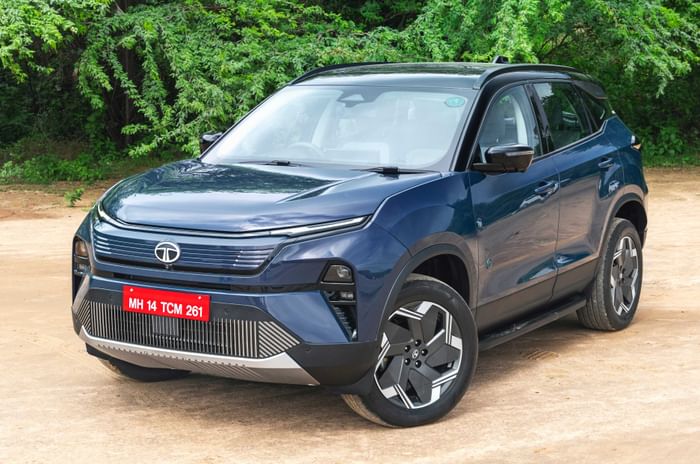The electric Harrier is finally here, and it’s loaded with features and a dual-motor, all wheel drive powertrain. We drive the Mahindra XEV 9e rival to see what it’s like.
By now you probably know most of what the Tata Harrier EV is about. We know the prices, the specifications and we even experienced it at a curated off-road event. Now, we’ve experienced it in the real world and put it through some preliminary performance and range tests to see just how good it is.
Tata Harrier EV: Design and engineering – 7/10
Not striking, but looks smart and has good road presence.
Compared to the ICE Harrier, the EV only gets some subtle styling differences. Up front, there’s a new closed-off grille with strakes, below which is a revised bumper and air intake area. Along the sides, there’s new aero-optimised 19-inch alloys and a small EV badge on the front door. At the rear, the only distinguishing elements are the Harrier EV badge on the tailgate and the absence of a tail pipe. Overall, the Harrier EV – like its ICE counterpart – is a handsome-looking SUV that’s big on road presence; however, it perhaps lacks the striking wow factor associated with modern EVs.
Design updates over the ICE-powered Harrier are quite subtle.
Under the skin, the Harrier is not a born-EV but a very massive ICE-to-EV conversion. While it shares the top hat with the regular Harrier, the Omega Arc platform from the ICE model has been thoroughly re-engineered to feature a completely flat floor and a new electrical and electronic architecture that Tata calls t.idal (Tata Intelligent Digital Architectural Layer). The Harrier EV comes with two drive layouts – the lower variants get a rear-wheel-drive setup using a permanent magnet synchronous motor and the higher variant get AWD capability using an additional front-mounted induction motor. This makes the Harrier EV Tata’s first 4×4 model since the Safari Storme and Hexa SUVs.
Tata Harrier EV: Interior space and comfort – 8/10
Spacious and comfy for both front and rear passengers.
Like the exterior, the interior is also largely shared with the ICE Harrier. So you get the same dashboard with touch-based AC controls, the same four-spoke steering and a digital driver’s display. The changes are the new 14.5-inch touchscreen (more on that later) and a different gear selector. Also new is the key fob, which is circular and can control various functions of the car, including the summon mode.
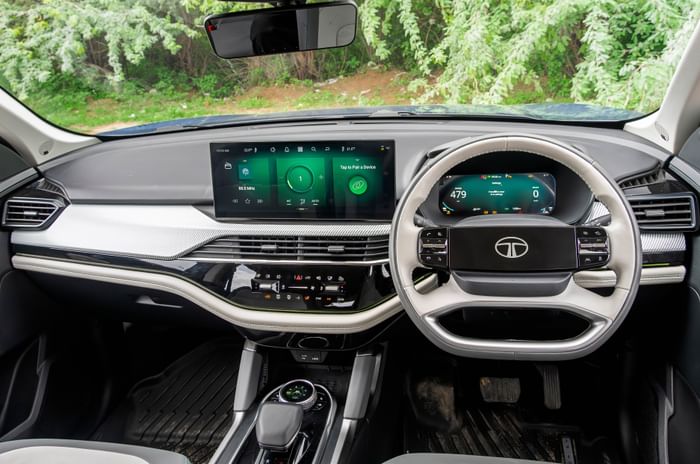
Interior updates include a new 14.5-inch touchscreen and a different drive selector.
The front seats are large and comfy and there’s plenty of adjustability to find your ideal driving position. However, taller drivers will find their knee rubbing against the centre console and the wireless charger isn’t easy to access, just like on the regular Harrier. There’s plenty of storage spaces too, including large door bins and a cooled cubby below the centre armrest.
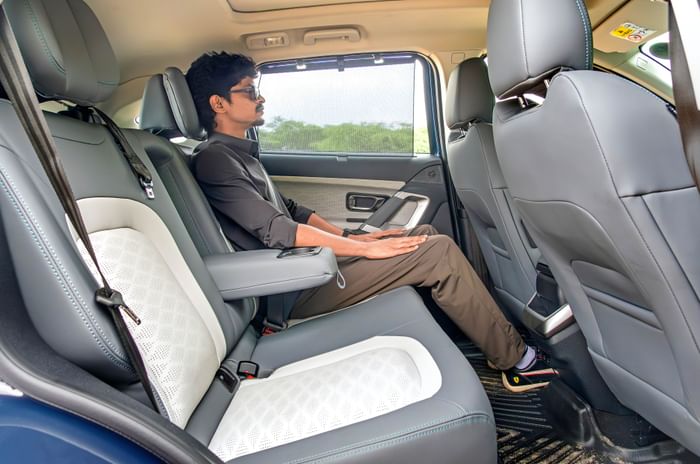
Three passengers can sit at the rear in reasonable comfort.
The rear seat is also a spacious and comfy place to be. There’s no shortage of legroom and kneeroom, you’re not sitting in a knees-up position unlike most EVs, and the flat floor means three adults can sit here in reasonable comfort. What adds to the experience for the outer passengers are the winged headrests, which hold your head in place; helpful for when you want to nap. You also get window blinds and a boss mode that lets you move the front passenger seat from the rear to liberate more room. Other features at the back include dedicated AC vents, an armrest with cupholders and USB Type-C ports.
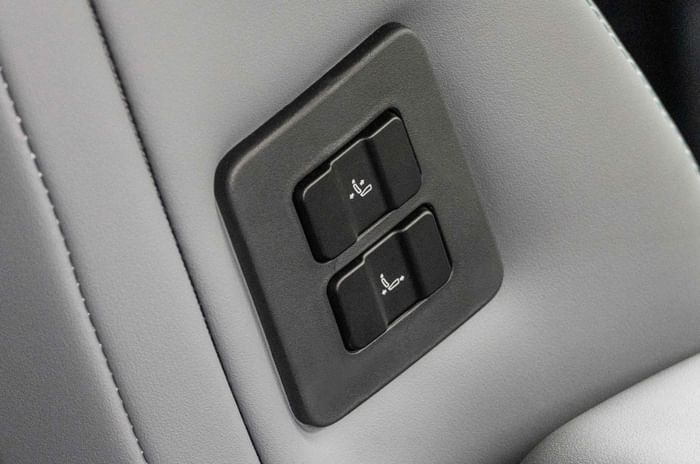
Boss mode helps free up additional space behind the front passenger seat.
Boot space is claimed at 502 litres, though that’s calculated up to the roof and not up to the parcel tray as in the diesel Harrier (445 litres). The electric Harrier’s boot space is lower given that the floor has risen to accommodate the rear motor, but it can still fit in quite a bit. What’s nice is that Tata has also provided a space-saver spare below. There’s also a frunk (67 litres on the RWD versions and 35 litres on the AWD).
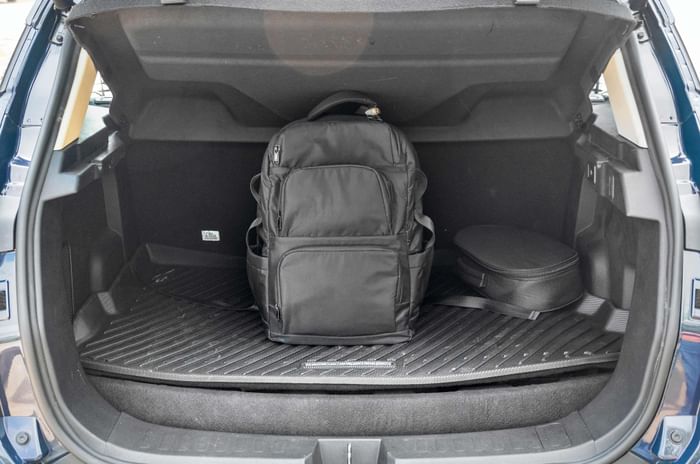
Boot has 502 litres of space, measured up to the roof.
Tata Harrier EV: Features and safety – 8/10
Not the lengthiest features list, but gets all the expected bits and a bit more.
The Harrier EV comes absolutely loaded with everything you’d expect in a modern EV. The highlight is the 14.53-inch Samsung Neo QLED touchscreen, which Tata says is the world’s first Neo QLED automotive display. This screen impresses with its resolution and vibrant colours, has in-built apps and games, and is slick to operate. There’s also a superb-sounding 10-speaker JBL Black audio system with Dolby Atmos 5.1, a UPI-based in-car payment system dubbed Drive Pay, ventilated and powered front seats, a panoramic sunroof, configurable ambient lighting, and much more.
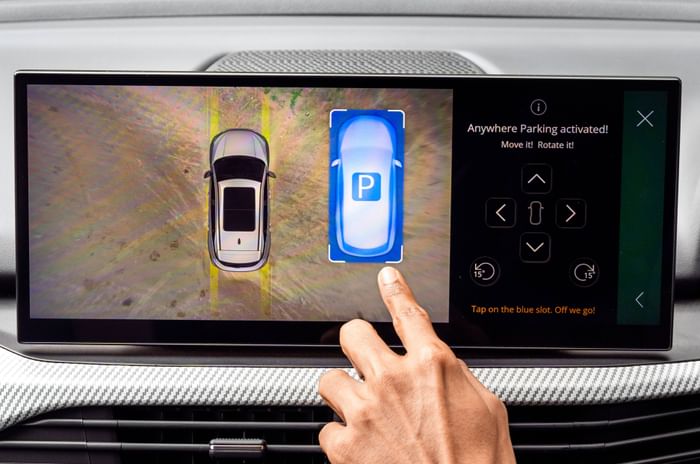
Parking camera resolution is low, and it’s a bit choppy.
There’s also a whole array of cameras: an in-built dash camera, a 540-degree parking camera, which gets a transparent bonnet feature, and uniquely, a digital rearview mirror. However, while the feed for the mirror appears crisp and smooth, the parking camera appears a bit too choppy and low res. It’s also worth noting that we did face some software-related glitches with our test car, like a flickering screen and random warning lights in the instrument cluster.
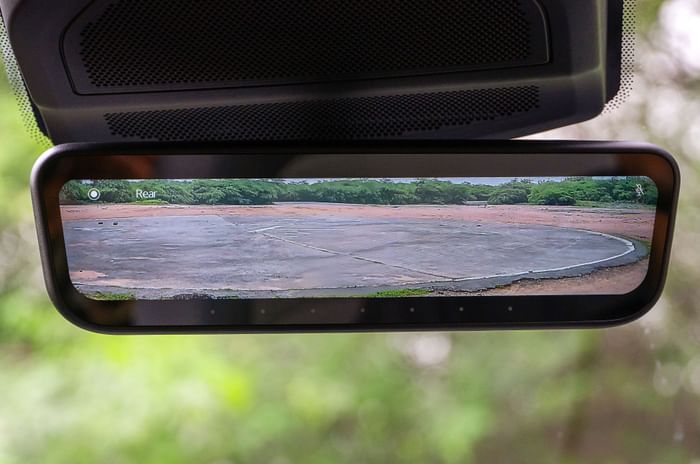
Feed from digital rearview camera is crisp and smooth.
Now, coming to the features that have perhaps been the biggest talking point. The Harrier EV gets a ‘Summon mode’, which allows you to remotely control the car to come out of tight parking spaces using the key fob. It doesn’t work smoothly though and there is certainly some room to refine the software here. Also present is an auto-park function, wherein the car will detect a parking spot and take over all the controls to help you park. There’s even the option to manually select a parking area should you want, and a reverse assist that memorises the last 50 metres of driving and automatically reverses to get you out of tight spots. What’s nice is that the auto park did work very smoothly on our test drive.
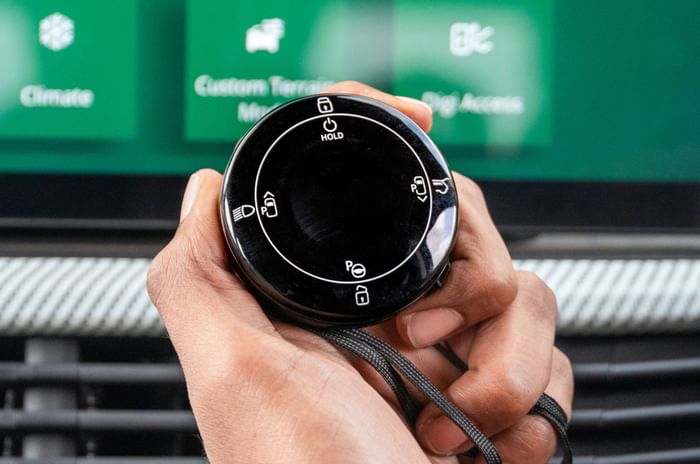
New circular key fob can be used to activate the ‘Summon mode’.
As for the safety kit, the Harrier EV gets 7 airbags, disc brakes all around, TPMS, and much more. Level 2 ADAS is also a part of the package and Tata says the autonomous systems have been calibrated specifically for our roads, including low-speed auto emergency braking (AEB). On our short drive, the ADAS systems worked well and rarely intervened unnecessarily. And to round it off, the SUV has also received a full 5-star crash safety rating from Bharat NCAP.
Tata Harrier EV: Powertrain and refinement – 9/10
Well calibrated and strong power delivery; it’s nice and refined too.
The range-topping Harrier EV we drove is dubbed QWD or Quad Wheel Drive, and it features a dual-motor setup – with one on each axle. Combined, they put out 313hp and 504Nm, which is enough to propel it from 0-100kph in a claimed 6.3 seconds. In our preliminary testing, it managed to do it in 6.65 seconds, which is plenty quick. It even impresses in roll-on acceleration, with 20-80kph taking 3.75 seconds and 40-100kph taking 3.92 seconds. For reference, the Harrier EV AWD is quicker than its chief rival, the Mahindra XEV 9e Pack Three, across all these parameters.
| Tata Harrier EV specs | ||
|---|---|---|
| Battery capacity | 65kWh | 75kWh |
| Drive layout | RWD | RWD/AWD |
| Power | 238hp | 238hp/313hp |
| Torque | 315Nm | 315Nm/504Nm |
While performance is strong as expected, what the powertrain really stands out for is its calibration. It feels very progressive right from the get-go, with no sudden spikes in power delivery, and it doesn’t dump all its power in one big chunk, which can feel overwhelming. The throttle pedal has a long travel, feels natural and is not like an on/off switch – even in the sportiest mode – unlike some other EVs. Furthermore, there’s drive modes – Eco, City and Sport – like any other Tata EV, but the Harrier also gets a new Boost mode in which it feels the most immediate. Rather uniquely, it gets a Drift mode too. Tata has also done a good job with the refinement as the cabin is well isolated from the outside world, with only some minor wind and motor noise creeping in.
Performance is progressive with no sudden spikes in power delivery.
Being a 4×4, there’s also six off-road modes for all sorts of terrain, and having experienced the Harrier EV on a light but slushy off-road trail, I can tell you that it feels very capable. Stay tuned, because we will soon be putting it to test off-road. There’s four levels of regenerative braking to choose from, operated via the paddle shifters, including a Level 0 that allows for coasting on the highway; however, there’s no single-pedal mode.
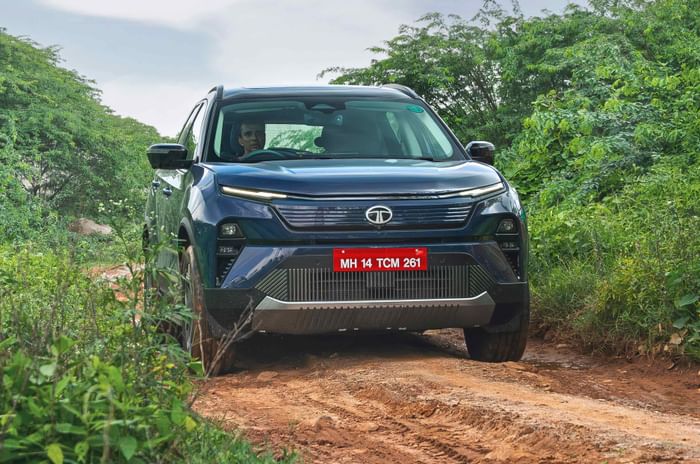
Harrier EV feels capable in all sorts of terrain thanks to all-wheel drive.
While the overall mechanical package is impressive, what is a bit of a downer are the brakes. The pedal feels spongy, there’s not much feel and you often have to press the pedal harder than expected to bring this big, heavy SUV to a stop.
Tata Harrier EV: Range and Efficiency – 8/10
Over 400km of real world range is easily achievable.
The Harrier EV QWD we drove comes with a 75kWh LFP battery pack that’s said to give it an ARAI range of 622km – or a more realistic 460-490km on Tata Motors’ C75 cycle, which represents 75 percent of the typical driving cycle from Tata Motors’ current customers. The rear-wheel-drive versions get a 65kWh battery with a lower 238hp output but a higher 627km (ARAI) claimed range. While we didn’t get a chance to do our in-depth real-world range test on the media drive day, we did manage to drain the battery from 98 percent to 3 percent, mainly on the highway and in Eco mode, during which the Harrier EV covered 414 km. This translates to an efficiency of 5.81km/kWh and a range of 436km, which isn’t far off the claimed C75 cycle.
| Tata Harrier EV range and charging | ||
|---|---|---|
| Battery | 65kWh | 75kWh |
| Claimed range (ARAI) | 627km | 622km |
| 7.2kW AC charging (10-100%) | 9.3 hours | 10.7 hours |
Tata claims a 120kW DC fast charger will top up the battery from 20 to 80 percent in about 25 minutes, while a 7.2kW AC charger is said to take 10.7 hours to charge it from 10 to 100 percent. Like most of Tata’s electric cars, the Harrier EV has vehicle-to-load (V2L) and vehicle-to-vehicle (V2V) capabilities.
Tata Harrier EV: Ride comfort and handling – 9/10
Brilliant ride and handling balance, especially over rough roads.
Harrier EV strikes a good balance between ride comfort and handling.
Without a doubt, the Harrier EV’s standout quality is its ride comfort. Key to this is what Tata calls ‘Ultra Glide Suspension with Frequency Dependent Dampers (FDD)’, which essentially offers you the best of both worlds. This setup gives the ride a cushy and composed feel without sacrificing the handling around bends. It particularly excels on broken surfaces and at low and medium speeds, where it simply irons out all the imperfections while keeping the occupants isolated. It’s only at higher speeds that you can feel a bit of vertical movement creeping in at the rear, especially over things like expansion joints, but it settles quickly and should feel better when fully laden. Handling is also predictable, with body roll kept well in check, and there’s decent grip on offer. The steering, which can feel heavy at low speeds, has good weight and feel at higher speeds, which inspires confidence.
Tata Harrier EV: Price and verdict – 8/10
Well rounded product that’s competitively priced.
The Tata Harrier EV priced starts at Rs 21.49 lakh for the Adventure 65kWh version, going up to Rs 28.99 lakh for the range-topping Empowered QWD 75kWh version you see here. At this price, it undercuts its main rival, the Mahindra XEV 9e, while offering similar range and the added advantage of AWD. Like the Mahindra, these prices do not include the cost of the 7.2kW AC charger and its installation, which is set at Rs 49,000.
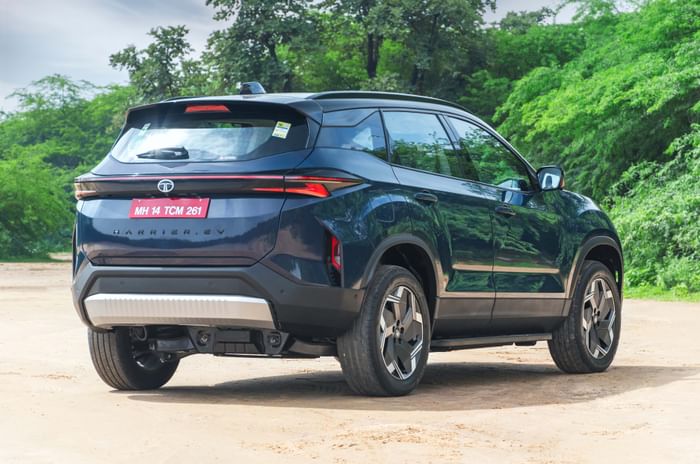
Harrier EV price undercuts those of its chief rival, the Mahindra XEV 9e.
The Harrier EV may not have the wow factor, or the longest features list, and it needs some software fine-tuning to become easier to live with. But it is a very well-rounded package. It impresses with its superb ride and handling balance, a powerful and well calibrated powertrain, a good real-world range, and it has a comfy and spacious cabin. To borrow a children’s fairy tale phrase then, it hits the Goldilocks zone; not too much, not too little. The question now is, is this what today’s electric car customers want?
Also See:
2025 Tata Altroz facelift review: Sharp suiter
MG Windsor EV Pro review: Going the distance
